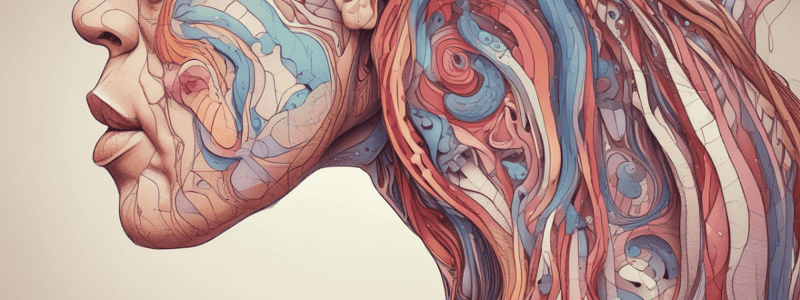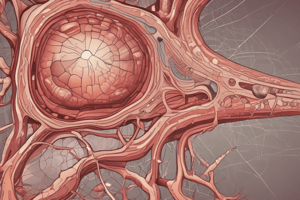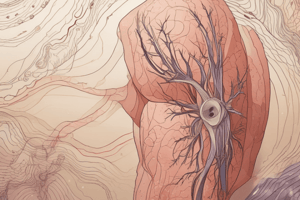Podcast
Questions and Answers
What is the primary function of the skin's sweat glands?
What is the primary function of the skin's sweat glands?
- To aid in the sensation of touch and pressure
- To remove waste products from the body
- To produce sweat to cool the body down (correct)
- To regulate blood pressure
What happens to the skin's blood vessels when it's cold?
What happens to the skin's blood vessels when it's cold?
- They remain the same regardless of the temperature
- They constrict to reduce blood flow to the surface of the skin (correct)
- They constrict to increase blood flow to the surface of the skin
- They dilate to reduce blood flow to the surface of the skin
What is the maximum amount of sweat that the skin's sweat glands can produce per day?
What is the maximum amount of sweat that the skin's sweat glands can produce per day?
- 12 liters (correct)
- 10 liters
- 8 liters
- 6 liters
What can cause the skin's color to change?
What can cause the skin's color to change?
What is the function of the skin's outer layer?
What is the function of the skin's outer layer?
What can certain skin conditions be indicative of?
What can certain skin conditions be indicative of?
What is the primary function of melanin in the skin?
What is the primary function of melanin in the skin?
Why are darker skin tones more prevalent in areas closer to the equator?
Why are darker skin tones more prevalent in areas closer to the equator?
What is the role of the liver and kidneys in the production of vitamin D?
What is the role of the liver and kidneys in the production of vitamin D?
What is the main component of hair?
What is the main component of hair?
What is the purpose of using hair balm?
What is the purpose of using hair balm?
What is the function of the root of a hair follicle?
What is the function of the root of a hair follicle?
What is the difference between apocrine and eccrine glands?
What is the difference between apocrine and eccrine glands?
What is the function of sebaceous glands?
What is the function of sebaceous glands?
What is the irony of many skincare products?
What is the irony of many skincare products?
What is the function of the integumentary system?
What is the function of the integumentary system?
Flashcards are hidden until you start studying
Study Notes
-
The skin, hair, and nails are not just for aesthetic purposes, but they also play a crucial role in maintaining overall health and protecting the body from external factors.
-
The skin is a complex organ that performs various functions, including regulating body temperature, aiding in the sensation of touch and pressure, and helping to remove waste products.
-
The skin's outer layer is made up of flexible tissues that are designed to withstand various stimuli, including pressure, temperature, and humidity.
-
The skin's ability to regulate body temperature is crucial, as it helps to maintain a stable temperature even in extreme environments.
-
When the body temperature rises, the skin's sweat glands are activated to produce sweat, which helps to cool the body down.
-
The skin's sweat glands can produce up to 12 liters of sweat per day, which is an essential function for maintaining body temperature.
-
The skin's blood vessels also play a crucial role in regulating body temperature, as they constrict to reduce blood flow to the surface of the skin when it's cold, and dilate to increase blood flow when it's hot.
-
The skin's color can change depending on various factors, including the amount of oxygen in the blood, which can cause it to appear blue or pale if there's not enough oxygen.
-
Certain skin conditions, such as jaundice or cyanosis, can be indicative of underlying health issues, such as liver or heart problems.
-
The skin's natural pigmentation, melanin, plays a crucial role in protecting the body from the harmful effects of UV radiation.
-
The distribution of melanin in the skin can vary depending on geographical location, with darker skin tones being more prevalent in areas closer to the equator.
-
This is because darker skin tones provide better protection against the intense UV radiation found in these areas, while lighter skin tones are more prevalent in areas with less intense UV radiation.
-
The skin's ability to produce vitamin D is also dependent on the amount of UV radiation it receives, with the skin producing more vitamin D in areas with more intense UV radiation.
-
Vitamin D is essential for maintaining healthy bones, and the skin's ability to produce it is crucial for overall health.• Vitamin D is transported through the bloodstream to the liver and kidneys, where it becomes activated as calcitriol, and is distributed throughout the body's bones. • The integumentary system includes not only skin but also appendages such as hair, nails, sweat glands, and sebaceous glands, all of which can be impressive and fascinating in their own ways. • Hair is essentially a collection of dead cells made of keratin protein, with the outer layer of dead cells forming a overlapping scales-like structure, making it rough and prone to breakage. • The goal of using hair balm is to smooth out the rough surface between the scales of dead cells, making it appear smooth and shiny. • When you pull out a hair from your scalp, it can be painful, but it also allows you to observe that it has two main parts: the root, which is inside the follicle, and the shaft, where keratinization is complete. • Each follicle is essentially a tube of epithelial cells, and like the skin, the cells at the base of each follicle are young, active, and constantly dividing, pushing older cells upwards through the skin to the surface. • Fingernails and toenails grow similarly, starting from the back of the nail bed, where new cells divide and push forward to produce the hard, keratin-based protein that makes up the nail plate. • There are approximately three million sweat glands distributed throughout the body, which produce a salty, watery secretion. • There are two types of sweat glands: apocrine and eccrine glands, with apocrine glands being more abundant in the palms of the hands, soles of the feet, and forehead. • Eccrine glands are less common, with around 2000 per person, and start functioning around puberty, producing a thicker, more protein-rich sweat that can be affected by bacteria on the skin, leading to body odor. • Antiperspirants do not affect the amount of sweat produced but reduce body odor by attacking the bacteria that cause it, while deodorants work in reverse, using ingredients like aluminum to block sweat glands and prevent sweat production. • Some researchers believe that these glands are the human equivalent of glands in other animals that produce pheromones to attract mates. • The mammary glands, which produce milk in lactating women, and the ceruminous glands, which produce earwax, are two other types of apocrine glands. • Sebaceous glands, found almost everywhere except on the thick skin of the palms of the hands and soles of the feet, produce an oily substance called sebum, which helps to moisturize and protect the skin and hair. • The main function of sebaceous glands is to lubricate and moisturize the skin and hair, helping to slow down water loss in dry environments, although they can also cause acne. • The irony is that many skincare products remove natural oils and then try to replace them with creams and balms.
Studying That Suits You
Use AI to generate personalized quizzes and flashcards to suit your learning preferences.




